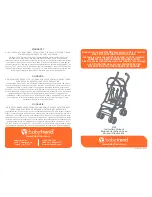
Settings
36
5
Figure 5.1
Heating curve graph - Each curve plots the outlet temperature against the outdoor temperature, when the room setpoint
temperature is 20 °C
Tacq water temperature
Tamb external ambient temperature
T amb
T acq
5.1.5
Setting the Room influence and Room
temperature limitation parameters
When a room unit is installed in a heated room (reference
room), it acquires the local temperature and interacts with
the control system. In particular, it may:
1. Modify the outlet water setpoint relative to the heat-
ing curve setpoint. If the reference room tempera-
ture stays below the requested value for too long or
reaches it too slowly, the water setpoint is gradually
increased. In the opposite case, the water setpoint is
gradually decreased. This compensates for errors in
selecting the heating curve or due to particular con-
ditions (variations in the internal thermal load, strong
winds, etc.). This compensating action can be made
more or less effective, to the point of completely sub-
stituting the heating curve system, or it can be disa-
bled. Heating circuit 1 and, if present, heating circuit 2,
are preconfigured to use this function in relation to the
included room unit 1 temperature reading, with a mild
compensating action (20%), which is suited to many
installations. To modify the degree of influence, or dis-
able the function:
for heating circuit 1, proceed as described in
Paragraph 5.1.1
p. 33 to edit parameter 750
(Room influence); for heating circuit 2, proceed
as described in Paragraph 5.1.2
p. 34 to edit pa-
rameter 1050 (Room influence). Set the influence
level as %, or set --% to disable the function.
Setting a value of 100 % disables the heating
curve. It is best not to use this setting, or even very
high influence percentages. For most applications,
do not exceed a setting of 30 %.
2. Interrupt the heating service request when the ref-
erence room temperature exceeds the setpoint by
a configurable amount. This action is similar to that
of a normal room thermostat or chronothermostat.
Heating circuit 1 and, if present, circuit 2 as well, are
preconfigured to use this function in relation to the
temperature read by room unit 1 (included), with a
value of 2.5 K (the service request is interrupted when
room unit 1 reads a temperature 2.5 degrees higher
than the setpoint). To change this setting or disable
the function:
for heating circuit 1, proceed as described in
Paragraph 5.1.1
p. 33 to edit parameter 760
(Room temp limitation); for heating circuit 2, pro-
ceed as described in Paragraph 5.1.2
p. 34 to edit
parameter 1060 (Room temp limitation). Set the
desired value, or set --°C to disable the function.
5.1.6
Setting the building time constant
Climate regulation does not directly use the outdoor













































